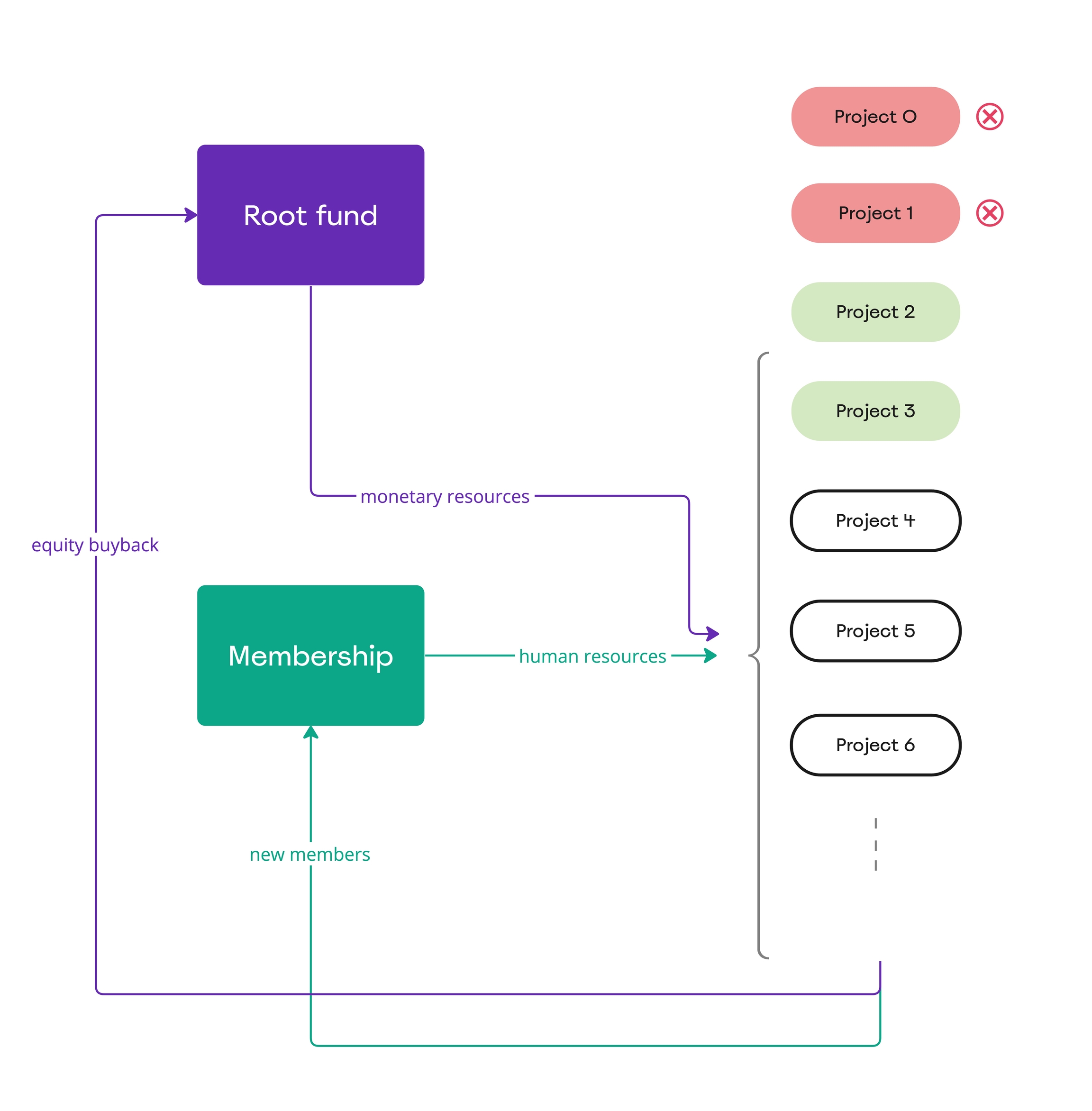How it works
Below life cycles illustrates how a SOFT based organization and its products operates.
A new SOFT org starts with a root fund to produce its first line of products. Each product produced at a SOFT organization is its own autonomous sub org. Org's root fund will hold certain percentage of equity ownership in each of the products produced. Once root fund attains enough capital gain from equity buyback from the Org's first line of products, it starts to fund further product proposals submitted by members of the org.
Any member(s) can submit a blue paper aka a proposal about the product which they want to build. Each new product will be build utilizing organization member's time resource and root fund monetary resource. Any member can contribute their time to the production of newly accepted proposals. The detailed information on how time contribution of members works is illustrated here: Membership, Collaboration.

Lifecycle of a product
Conception and development
The life cycle of a product starts with conception. The member who conceives the idea of a product is called conceiver. Following conception, either conceiver alone or conceiver along with others, develops the idea into a functionality and implementation document called blue paper. All the members involved until this stage are called developers. The developer(s) publishes the primer from the blue paper within the organization. Alternately, the developer(s) can choose to publish the idea itself without much implementation details as a white paper.
Pre production
If the proposed product primer successfully secures enough time contributions from members or secures seed money from root fund, the product can move into the production phase. The root fund provides seed money to the proposed product if it receives sufficient votes from members who have root fund voting privileges. Detailed voting privileges, member types and voting threshold definitions is depicted in Membership. If the product doesn't receive monetary help from org's root fund, root fund will not hold any equity ownership in the product.
In some cases, the product development team may need to raise additional funding to bring the proposed product to market. Such funding may be necessary if the product does not secure seed funding from the root fund or if there are not enough time contributions pledged from the organization's members or if the product requires heavy time or monetary resources. This can be done through various means, including equity ownership offerings, lending agreements, or donations. These funding activities are typically carried out by individuals or organizations known as backers, who provide the necessary financial resources to support the product's development. The type of funding provided can vary, with backers potentially receiving equity in the product, providing funding as a loan, or making a donation. See Incentives on how incentives work for these types of funding.
If the product development team chooses to raise extra funding while being part of SOFT org, they must comply with all applicable bylaws of the SOFT organization. This ensures transparency and accountability in the fundraising process, as well as the fair distribution of ownership and profits. The team must carefully consider the terms and conditions of any funding agreements, ensuring that they align with the organization's values and goals. By taking a responsible and strategic approach to fundraising, the product development team can ensure that they have the necessary resources to bring their product to market, while also upholding the values and principles of the SOFT organization.
Production
This phase involves the actual production of the product, with the goal of bringing it to market as quickly and efficiently as possible. The production phase typically involves close collaboration and communication among team members, as well as ongoing iteration and testing.
Consumption and maintenance
If the product once produced succeeds to acquire customers, the consumers of the product will automatically become members of that product’s sub and thus will also become members of the org. Each product operates as an autonomous sub within the larger SOFT org, with its own resource allocation, accounting, and operating costs. Product maintainers may allocate their time and resources to support the product, and operating costs may include expenses such as server and infrastructure costs. By functioning as a sub, each product is able to operate independently while still benefiting from the larger SOFT org's community and resources. The product can choose to raise additional funding during maintenance period complying org's bylaws.
Retirement
Product sub co-operative members with enough voting privilege can together choose to retire the product by voting, meeting retirement voting threshold. This can happen in scenarios where the product is no longer required or if it's existence is altruistically doing more harm than good.
Last updated
Was this helpful?